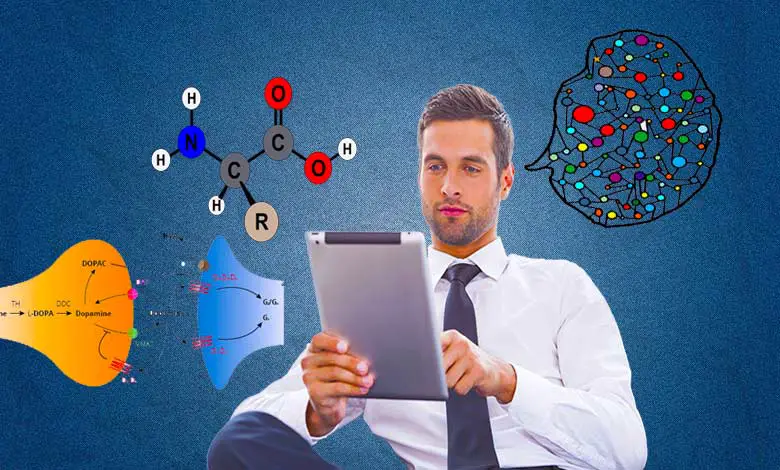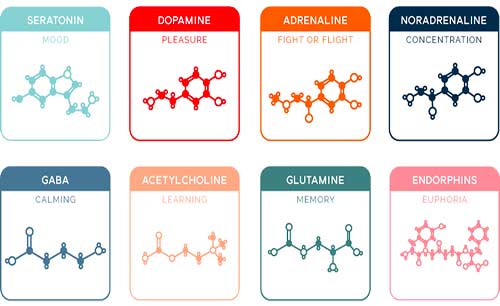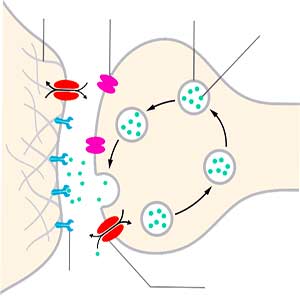
Neurotransmitters are chemical messengers and compounds that affect how we feel in our moods. Neurotransmitters are chemical messengers. They sit between the post and presynaptic cleft and help jump the action potential or connect the presynaptic neuron to the postsynaptic neuron.
Neurotransmitters work by transmitting signals from one neuron to another across synapses, the small gaps between neurons. They bind to receptor sites on the receiving neuron, influencing it either to initiate or inhibit an electrical signal, thus playing a crucial role in how brain cells communicate and ultimately affect our thoughts, feelings, and behaviors.
Diving into the microscopic world of our brains, neurotransmitters play the leading role in a complex performance, orchestrating every thought, emotion, and action. These chemical messengers are the unsung heroes of our neurological processes, facilitating communication between neurons in a way that influences everything from how we move to how we feel. Understanding how neurotransmitters work unlocks a deeper appreciation of the intricate ballet happening within us every moment of our lives.
What are neurotransmitters?
Neurons release neurotransmitters, either having an excitatory or inhibitory effect. If we look at a neuron releasing a neurotransmitter, it releases it into the gap. This gap is called a synapse. It’s the gap between one neuron and the next neuron.
Neurotransmitters that will bind to the next neuron will either excite it to send a signal or inhibit it from sending a signal. They don’t bind to neurons. Also, they may bind to muscles, cells, or glands. They can bind to multiple different effectors, which will elicit some change.
Types of neurotransmitters
Different types serve different functions, so let’s get a closer look at these now.

While many compounds qualify as neurotransmitters, let’s start with the most common ones: Small molecules of three classes.
These are given below:
- Amino acids.
- Monoamines.
- Acetylcholine.
1. Amino acids: Glutamate, aspartate, glycine, and gamma-aminobutyric acid, or GABA for short, which is derived from glutamate.
2. Monoamines: Dopamine, epinephrine, norepinephrine, and serotonin. The first three are categorized as catecholamines, while serotonin qualifies as indolamine.
- The catecholamines are synthesized by tyrosine enzymes and converted into L-dopa in steps. Then dopamine, then norepinephrine, and then epinephrine.
- By contrast, serotonin is synthesized from tryptophan.
3. Acetylcholine: This is in a class of its own and is simply a choline molecule that has been acetylated.
- This molecule should be very familiar from our study of the neuromuscular junction in the anatomy and physiology course due to its role in promoting muscle contraction.
4. Unconventional: Another class of unconventional neurotransmitters doesn’t fit into the other categories. This includes small molecules like nitric oxide and carbon monoxide.
These are of a different class because they are extremely small and nonpolar.
- They can pass through the cell membrane and thus freely diffuse in and out of cells without passing through membrane proteins.
- Once produced inside a neuron, they move into other cells, stimulating the production of second messenger molecules. Then, they are quickly converted into something else, so they are short-lived.
- Sometimes, these molecules are involved in retrograde transmission, where they travel from the postsynaptic neuron back to the presynaptic, opposite the direction of travel for other neurotransmitters.
Another class of unconventional neurotransmitters is endocannabinoids, which are also retrograde transmitters.
- These are similar in structure to delta-9-tetrahydrocannabinol. The psychoactive agent in marijuana, and similar functions, as they bind to endocannabinoid receptors.
There is also one class of very large neurotransmitters: the neuropeptides. These polypeptide chains are large enough to qualify as a protein.
Each has a different function, depending on its amino acid sequence. They are categorized primarily according to their location in the body.
Here are:
- Pituitary peptides in the pituitary gland.
- Hypothalamic peptides in the hypothalamus.
- Brain-gut peptides in the gut.
- Opioid peptides resemble opium.
- All the other miscellaneous ones are grouped into a fifth category.
How do neurotransmitters work?
There’s a set of chemicals in the body that cause how you feel, how you think, and whether or not you sleep well. They’re called neurotransmitters. They involve virtually every physical, cognitive, and emotional activity. Neurotransmitters transmit signals across the synapses, the tiny gaps between neurons. The process of neurotransmission involves several steps:
Synthesis: Neurotransmitters are synthesized within the neuron. They are produced from precursor molecules through various enzymatic reactions. The synthesis occurs in specialized structures within the neuron, such as the cell body or the nerve terminals.
Storage: Once synthesized, neurotransmitters are packaged into vesicles, which are small sac-like structures within the nerve terminals. These vesicles act as storage containers for neurotransmitters until they are released.
Release: When an electrical impulse, known as an action potential, reaches the nerve terminal, it triggers the release of neurotransmitters. The action potential causes the vesicles containing neurotransmitters to fuse with the cell membrane, releasing the neurotransmitters into the synapse.
Diffusion and Binding: The released neurotransmitters diffuse across the synapse, the narrow gap between the sending neuron’s terminal and the receiving neuron’s dendrites or cell body. They travel in the extracellular fluid and bind to specific receptor proteins on the receiving neuron.
Receptor Activation: When neurotransmitters bind to their specific receptors on the receiving neuron, they induce a change in the receptor’s shape or activity. This activation can either excite or inhibit the receiving neuron, depending on the specific neurotransmitter and receptor involved.
Postsynaptic Potential: The receptor activation leads to the generation of a postsynaptic potential in the receiving neuron. This potential is an electrical signal that influences the neuron’s excitability and the likelihood of generating an action potential.
Termination: To stop the signaling process, neurotransmitters must be cleared from the synapse. This can occur through various mechanisms, including reuptake, where the neurotransmitter is taken back into the sending neuron for reuse or enzymatic breakdown of the neurotransmitter in the synapse.
If these neurotransmitters have been changed because of stress or trauma, or malnutrition, we may have a child who’s dramatically altered physiologically. Let’s also briefly outline some details regarding function.

- First, neurotransmitters will exhibit two effects when they reach their respective receptors’ active sites.
- Electrochemical activity propagates along an axon, resulting in one of two things. With an electrical synapse or gap junction, ions can flow from one cell to the next. But with a chemical synapse, neurotransmitters are released at the axon terminals. These interact with receptors on the post-synaptic neuron, and the signal continues.
- They will either cause excitation or inhibition. This is like flipping a switch on or off. More specifically, an excitatory response will depolarize the post-synaptic neuron, while an inhibitory response will produce hyperpolarization for the post-synaptic neuron. So it’s the difference between propagating a signal and halting it.
- Some neurotransmitters produce one effect over another, like how glutamate is typically excitatory, while glycine and GABA are typically inhibitory.
For others, it depends on the context. Acetylcholine is excitatory at the neuromuscular junction for skeletal muscles but inhibitory in cardiac muscles.
Next, we must distinguish between direct and indirect action.
Direct action: Direct action is when a neurotransmitter binds to an ionotropic receptor and opens it up so ions can pass through.
- This will affect the membrane potential and promote the rapid propagation of a particular effect.
- Acetylcholine and amino acid neurotransmitters tend to behave this way.
Indirect action is promoted through second messenger molecules, like the G proteins.
It is similar to how hormones operate, and metabotropic receptors mediate the activity. The monoamines, neuropeptides, and small gas molecules will exhibit this behavior. When these act as chemical messengers in this manner, we sometimes call them neuromodulators.
Neurotransmitters and their functions
Acetylcholine: Acetylcholine has two major types of receptors.
- Nicotinic.
- Muscarinic.
Now depending on what it wants to do depends on the receptor. For example, our peripheral nervous system is divided into the central brain, spinal cord, and peripheral.
- Acetylcholine plays a significant role in skeletal muscle contraction, muscles attached to our bones.
The specific receptor involved here is the muscarinic receptor, which means you can have certain drugs that we can use to act on muscular receptors that can affect the way we move our muscles.
- Acetylcholine also plays an essential role in the autonomic nervous system, specifically the parasympathetic division. It is the rest and digests the autonomic nervous system, which is sympathy dick fight-or-flight parasympathetic rest and digest.
- The parasympathetic uses acetylcholine at every single neuron. The sympathetic only use it from the first neuron. The second neuron sends a signal and talks to the target effector. It could be a muscle, gland, or cell type. It will be the digestive system, the heart, the pupils, and the saliva glands. This is the parasympathetic acetylcholine released at every single point.
It’s essential in rest and digestion, but the spinal cord plays a vital role in memory and cognition in the central nervous system brain. It has been implicated in Parkinson’s disease, the most common movement disorder. Alzheimer’s disease is the most common neurodegenerative disorder.
Catecholamines: Catecholamine is an umbrella for three neurotransmitters. They are:
- Noradrenaline
- Adrenaline
- Dopamine
These three neurotransmitters are produced by the amino acid tyrosine, which we must get from our diet. We can’t create ourselves. We can make it from phenylalanine, but we must also get phenylalanine from our diet.
There are a couple of different receptors that are used. You can have α1, α2, β1, β2, β3. Let’s ignore β3 because they’re only found on fat cells. We don’t have any drugs that utilize this receptor.
Let’s look at α1 and β1. If noradrenaline or adrenaline balances these receptors, it’s excitatory. For example, alpha one is found in our blood vessels.
For example, our noradrenaline binds to alpha1 blood vessels, which will constrict blood pressure. Beta1 is found in our heart when noradrenaline bonds to increase the heart rate and the heart’s contractile force.
- Alpha 2 (α2) is found on the postsynaptic neurons, so that’s the second neuron. What it does is that it is auto-regulates the sympathetic nervous system. It stops the sympathetic nervous system from firing off any more signals. So, it’s like a negative feedback system.
- Beta 2 (β2) is found in our lungs if noradrenaline binds to this. It opens the airways up, and some more air comes in and out of the central nervous system.
- Adrenaline and noradrenaline are necessary for opioid release. It is our endogenous opioid system. So opioids are there for pain anxiety. This is involved in the opioid release of adrenaline.
- Dopamine is a reward molecule, our feel-good molecule. It does play a role in the central nervous system. It’s involved in initiating motor movement and smoothing out motor movement. Now, in people with Parkinson’s disease, the neurons that make dopamine are dying off. Dopamine plays a role in blood vessel diameter and the kidney’s role in excreting sodium.
Serotonin: Serotonin is also known as 5-HT. It plays an important role in the central nervous system with sleep and mood, and the peripheral nervous system plays a role in our GRT. If neurons release serotonin in our gut, that’s right. We’ve got neurons in our stomachs that release serotonin.
- It stimulates the gastrointestinal tract to contract and pushes things through too much, pushing through far too quickly.
- It also plays a role in bone remodeling, making the bone stronger.
Gamma-aminobutyric acid (GABA): GABA is the primary inhibitory neuron of the nervous system. So, it inhibits neurons from firing off. That’s a significant role.
- It stops neurons from firing by throwing negative chloride into the cells. If the cells become super negative, called hyper-polarization, they won’t fire off.
Glutamate: Glutamate is the most common or abundant excitatory neuron in the nervous system. It has two major types of receptors, NMDA in AMPA. If stimulated and they will tell neurons to fire off. You can have glutamate toxicity too much.
- Glutamate being released can kill brain cells and has been implicated in dementia. This glutamate toxicity theory has been associated with dementia and Alzheimer’s disease.
Substance P: Substance P for pain. This is involved in the pain system. What will happen if substance P is released into the peripheral nervous system?
- The central nervous system stimulates pain and inflammation, so we sometimes want to identify certain drugs that we can use against the substance P to help mitigate pain.
Diving into the microscopic world of our brains, neurotransmitters play the leading role in a complex performance, orchestrating every thought, emotion, and action. These chemical messengers are the unsung heroes of our neurological processes, facilitating communication between neurons in a way that influences everything from how we move to how we feel.
Understanding how neurotransmitters work unlocks a deeper appreciation of the intricate ballet happening within us every moment of our lives. If you have any questions, then please feel free to ask.
Read More: What Does Dopamine Do For The Brain?
References:
Lodish, H.; Berk, A.; Zipursky, S.L. Molecular Cell Biology: Section 21.4 Neurotransmitters, Synapses, and Impulse Transmission (4th ed.). New York: W. H. Freeman.
Cherry, Kendra. “What is a Neurotransmitter?”.
“Neuropeptides. IUPHAR/BPS Guide to pharmacology”.
Elias, L. J, & Saucier. Neuropsychology: Clinical and Experimental Foundations. Boston: Pearson
Saladin, Kenneth S. Anatomy and Physiology: The Unity of Form and Function. McGraw Hill.
Table of Contents
